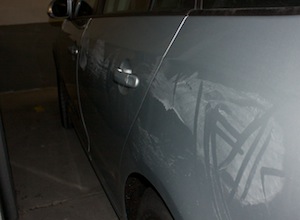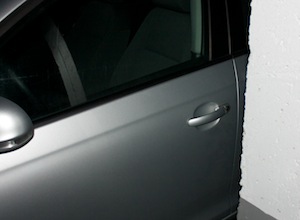This could be a short post. As it turns out, the concept of “car care” is somewhat mythical in France. After our first visit to France and seeing that all of the cars are dented and missing parts (mirrors, etc.), Tiffany and I decided that we had to buy our car in Germany where things are very much the opposite.
This is probably the number one reason why I couldn’t see staying in France forever. It is nearly impossible to keep a car in good condition here. French drivers (in general; there are many exceptions) treat the other cars in the parking lot as if they only exist to help them determine when they are all the way in their spot or when their door is open all the way. I always park in a nice end spot at the lab, where only my coworkers park around me. Even though Chalon-sur-Saône doesn’t have particularly tight parking, drivers can’t be trusted. In the United States this can be a problem too, but there they at least know in the back of their minds that they are doing something wrong.
The French explain it away, saying they treat their cars like tools. This is a bad attitude for a few reasons. First, driving is a big responsibility and I can’t respect anybody who does it but doesn’t take pride in it. If they can’t be bothered to avoid other cars in the parking lot, what about small children? Second, the car represents a large investment, both financially and environmentally. It’s only responsible to treat it well to maximize its life. Even if they don’t intend to keep it long, they could leave some life in it for the next guy. Finally, I don’t really care how they treat their cars (well, I like the environment so I do care a little). When they damage my car is when we have a problem.
Repair shops
Despite this, I have managed to get decent car repairs in France. The Volkswagen dealership is about the same as in any country (high priced, but seemingly solid work). My biggest problem with the VW dealership in Chalon-sur-Saône (Saône Automobiles) is that I caught the service advisor resting my door on another car one time. He said, “Oh there’s a plastic strip so it’s OK.” Some of my coworkers are pretty car-conscious and they agreed this was unacceptable.
For little stuff we can go to Feu Vert. It’s a chain of general-service garages something like Goodyear in the US. I don’t like to trust chains like this for VW-specific stuff, but they are friendly and fine for the little standard stuff. We also go to Profil+, which is another such shop. They are great because they do free inspections. In two visits they have found nothing wrong, so I guess they are pretty honest. Of course, I suppose they are also French so maybe their calibration is off. Both of these shops and the dealership have always been able to communicate with me in some combination of English and basic French with no problems.
Finally, I discovered a place called L’Atelier Self Auto. This is a really cool concept where they let you rent shop space to work on your own car. They have tools, lifts, and fluid catch pans. For extra, they will allegedly help with the repair. I just went there one time to do an oil change and I was very happy with it. I’d like to see more of these places around the world. I suppose liability is tricky but it’s really awesome to facilitate car owners trying to learn about their cars. Plus I get to do the repair the right way with the best parts.



 Fromage
Fromage